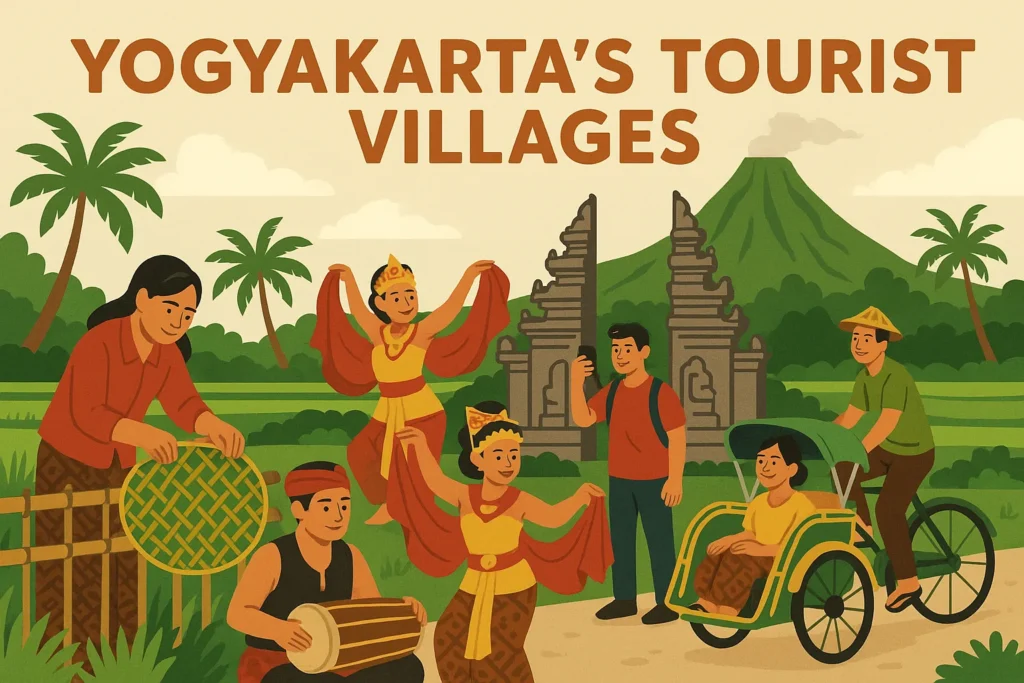Yogyakarta, a city of culture and education, always captivates tourists. But beyond the bustling Malioboro and the magnificent Keraton, hidden gems await: its **tourist villages**. If you’re interested in exploring the rich tapestry of destinations across Indonesia, including unique corners like Yogyakarta, be sure to check out our pillar article on Tourist Destinations in Indonesia.
A recent in-depth study published in the Journal of Tourism and Economic reveals the immense potential of these charming villages. The article, titled “Exploring the Potential of Tourist Villages in Yogyakarta City as a Tourist Attraction,” written by Wisnu Hadi from Universitas Bina Sarana Informatika, offers a comprehensive overview of how these villages contribute to the city’s tourism appeal.
See Table of Contents
Why Yogyakarta Remains a Favorite Destination?

As the capital of the Special Region of Yogyakarta, the city offers a unique blend of preserved traditions, warm hospitality, and a noble cultural heritage. The strong Javanese traditional values are a primary asset in tourism development, making it a cultural icon that attracts both domestic and international tourists.
The Unique Potential of Each Tourist Village in Yogyakarta
The research highlights that each tourist village in Yogyakarta possesses a rich variety of potentials. These include arts, culture, historical heritage, education, distinctive culinary experiences, and creative economic opportunities. Areas rich in art, culture, and historical buildings are always prioritized for tourism development based on local wisdom.
Here are some highlights of the tourist villages ready to enchant you:
1. Pakualam Tourist Village: Explore Palace Culture & Local Cuisine
Discover an Adventure and Heritage experience here. You can explore the village, learn to make traditional herbal medicine (*jamu*), or participate in *jemparingan* (traditional Javanese archery). Don’t miss the unique local delicacies like fried chicken and *rujak* ice cream typical of the Paku Alam Palace grounds!
2. Pandeyan Umbulharjo Cultural Tourist Village: A Hub of Art and Tradition
Rich in local culture, this village boasts art groups like Bergodo Rakyat Lombok Ijo. At Pendopo Krido Budoyo, visitors can watch or even practice traditional arts such as *karawitan* and *ketoprak*. There’s also Sanggar Batik Jenggolo for those interested in learning batik making.
3. Warungboto Tourist Village: History, Nature, and Delicious Food
Enjoy a blend of historical tourism at Situs Tuk Umbul, educational tourism at Gembira Loka Zoo, and fun water activities at Tirta Wisata “Wolulas” on the Gajah Wong River. Be sure to try the legendary Bakpia Kurnia Sari and Gudeg Pawon here.
4. Cluster Rejowinangun Tourist Village (Kotagede): Silver, Herbs, and Special Culture
Famous as a silver craft center, this village is also known as a “Herbal Village” (for traditional herbal medicine making) and a “Culinary Village.” Don’t miss the annual *wiwit pari* traditional ceremony, which marks this “Special Cultural Village.”
5. Tahunan Tourist Village: Karawitan Music and Ethnic Fashion
This village preserves *karawitan* music and is known as a “Fashion Village” thanks to its unique *jumputan* fabric crafts. You can also find pilgrimage sites like Taman Makam Pahlawan Kusumanegara (Heroes’ Cemetery).
6. Prenggan Tourist Village: Historic Alleys and Culinary Delights
Experience exploring the narrow village alleys with artistic buildings. Discover leather and silver craft centers, learn to make traditional foods like Yangko/Kipo, and enjoy a captivating night culinary tour.
7. Kadipaten Keraton Tourist Village: Near the Palace, Full of Art and Heritage
Characterized by “Art and Heritage,” this village is located near the Yogyakarta Palace. It offers *Heritage Tracking* packages, *Dinner At Heritage* with Wayang Wong dance performances, *Gejog Lesung* traditional music, and classical dance and gamelan lessons.
8. Dewabronto Tourist Village: Education, Batik, and Local River Wisdom
Combines educational tourism (museums, Ndalem Poegeran), batik crafts, traditional cuisine (wedang Bajigur, sate Telo), and environmental preservation activities along the Code River.
9. Sayidan Tourist Village: A Fusion of Culture and Creativity
Known as a “multicultural village” due to its ethnic diversity. Sayidan offers ecoprint crafts, local culinary treats, homestays, art galleries, and is even the base for the band Shaggy Dog!
10. Becak Maju Tourist Village: Water Adventure and Environmental Education
Utilizes the Winongo River for river tours, tubing, and outbound activities. This village also focuses on river ecosystem education and disaster risk reduction.
11. Sekar Niti Gedongkiwo Tourist Village: Village Exploration and Traditional Archery
Experience exploring the village to see valuable historical buildings and learn traditional archery in an authentic Javanese style.
Synergy of Government and Community: Key to Tourism Development
The development of these tourist villages is inseparable from the active role of the Yogyakarta City Government and the Tourism Office. Various exhibitions and digital promotions are continuously carried out to introduce their potential. Community empowerment is also emphasized through training in tourist village management, ensuring sustainable growth.
Come Explore Yogyakarta’s Hidden Gems!
Yogyakarta’s tourist villages offer authentic and diverse experiences away from the main tourist crowds. With their unique characteristics and strong support from various parties, this potential continues to be explored. So, if you’re looking for a new adventure and want to feel the true pulse of local life in Yogyakarta, plan a visit to these amazing tourist villages!
Further Information:
This article is inspired by research published in the Journal of Tourism and Economic, Vol.2, No.2, 2019, pages 129-139. The author is Wisnu Hadi from Universitas Bina Sarana Informatika. You can access the original journal article for more in-depth information via this link: https://jurnal.stieparapi.ac.id/index.php/jtec/article/view/96.
